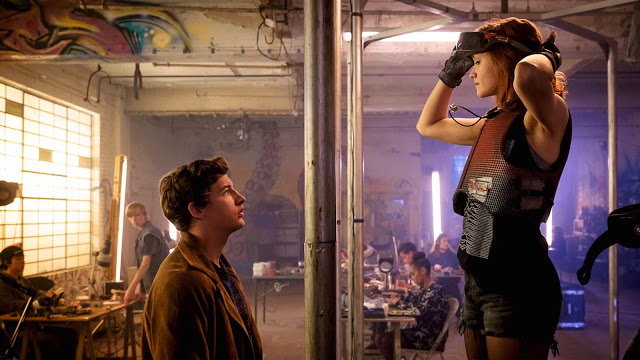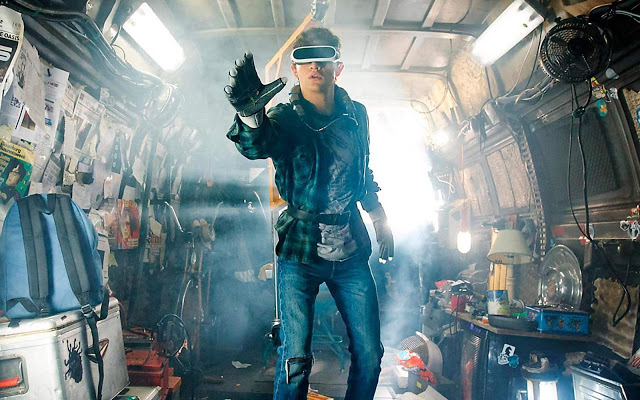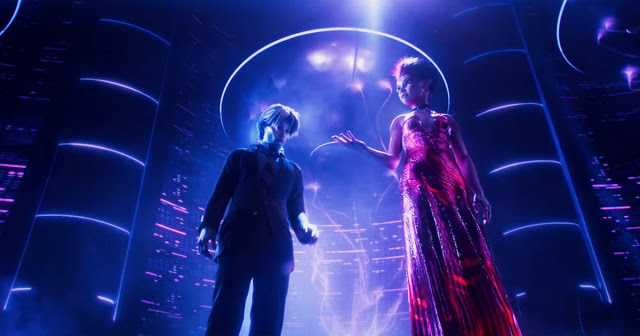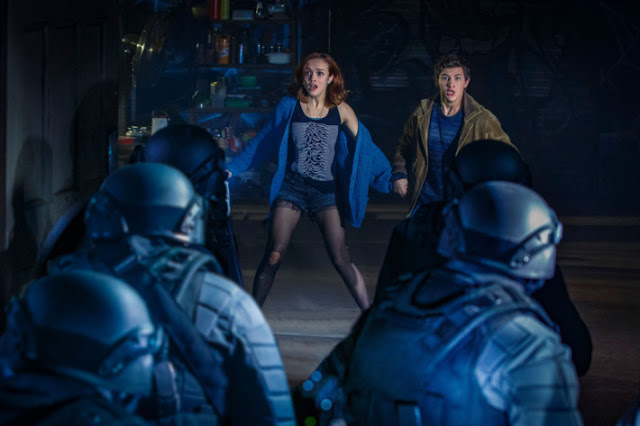Stop me if you’ve heard this before: An intrepid young man, living in a dystopian future, must use his pluck and ingenuity to defeat a powerful villain whose mercenary greed threatens our hero’s livelihood, along with the rest of the planet’s. In so doing, he will assemble a ragtag team of similarly disenfranchised youths, one of whom will catch his eye as a potential love interest, another of whom will support him with weapons and wisecracks. Foes will be vanquished, bonds will be forged, and while setbacks will surely be suffered (tertiary characters may even be killed), in the end, the world will almost certainly be saved.
Ready Player One, the robust and flawed film adaptation of Ernest Cline’s immensely popular book, doesn’t so much follow this familiar script as live inside it. It envisions a universe where the very act of engaging with popular art—mostly playing videogames, but also watching movies and spotting references—becomes the fulcrum of its story. It’s a recursive premise that’s less interesting than it sounds, primarily serving as the excuse for a non-stop parade of pop-culture allusions and winking asides. And perhaps in an alternate dimension—maybe one reached by traveling through some sort of vaguely defined wormhole whose laws are breathlessly explained to us in a bout of foggy exposition—Ready Player One would have been a piece of hackwork that turned out to be a tedious, imitative slog. But in our reality, it’s better than that, because in our reality, it’s been directed by Steven Spielberg.
In his late period, Spielberg has largely used his preternatural storytelling gifts to illuminate key episodes of wartime history: American slavery (Lincoln), World War I (War Horse), the Cold War (Bridge of Spies), Vietnam unrest (The Post). Every so often, however, he has turned to adapting works of kid-lit fiction (The Adventures of Tintin, The BFG), allowing him to both indulge his boyhood sensibilities and remind audiences just how skilled an action director he is. And Ready Player One finds the 71-year-old legend as spry and capable as ever, operating with balletic grace and rousing verve. Until it stumbles in its turgid third act, this movie is an inspiring accomplishment of lithe and energetic filmmaking. The story Spielberg’s telling may be secondhand, but there’s nothing derivative about the way he tells it.
Structurally speaking, Ready Player One functions a bit like a videogame, building a series of increasingly challenging levels that its contestants must battle through in order to achieve ultimate victory. (If you’re interested in a rote comparison of how the film adheres to or diverges from the book, I should note that I haven’t read the novel, and I will politely remind you that this is, in fact, a movie review.) As we learn from a brisk opening info-dump, the year is 2045, and most humans live in relative squalor. Seeking an escape from their desultory lives, they don gloves and glasses and plug into the Oasis, a sprawling virtual universe created by James Halliday (Mark Rylance, brimming with quiet humanity), an ingenious designer who lacked connectivity in his life and so manufactured it in his work. After his death, a posthumous video surfaces in which Halliday reveals that he has hidden three keys within the Oasis; first to find them shall obtain ownership of the company.
This basic quest setup is all Spielberg needs to dive in and dazzle us with boisterous innovation and supple craft. One of the pleasures of the Oasis, we’re told, is that it affords you the possibility of being anyone you want (gamers develop customized avatars, false faces to present to the world). And in rendering this computer-generated palace, Spielberg plainly delights in the same sort of freedom. Working with the production designer Adam Stockhausen (who deservedly won an Oscar for The Grand Budapest Hotel), Spielberg has constructed a marvelously detailed digital cosmos, teeming with intricate detail and towering wonder. Yet he doesn’t overwhelm you, and while the Oasis certainly pulsates with anything-is-possible potential—visitors can effortlessly change hairstyles, skin colors, and sizes—it nevertheless feels rooted in physical rules, with a tactile realism that occasionally makes you forget you’re watching a computer simulation.
This tangible dynamism extends to the film’s many set pieces, which are both visually stunning and spatially coherent. An early racing sequence could have been lifted from classic SNES titles like F-Zero or Top Gear, but Spielberg’s camera dips and dives across multiple planes, boosting your adrenaline without assaulting your senses. Even less action-heavy scenes hum with casual bravado, such as a trip to a nightclub where dancers leap off platforms and find themselves suspended in midair.
Of course, the allure of Ready Player One is not just the application of vigorous professional craftsmanship, but the integration of that craft into a universe laden with cultural touchstones. Every scene seems to feature at least a dozen callbacks to the entertainment of the ’80s and ’90s, plus other eras. And so, King Kong tears up that racetrack, as does a tyrannosaur from Spielberg’s own Jurassic Park. One character drives a DeLorean, while another morphs into the Iron Giant. Hell, in one scene, the hero and the heavy debate the merit of classic John Hughes films.
It’s fun! But it’s also complicated. For one thing, this approach of relentless homage can be exhausting; I enjoyed spotting as many references as I could—two of my favorites were nods to Terminator 2 and Excalibur—but countless more no doubt sailed over my head, and catching as many as you can can sometimes feel like a chore. It also creates barriers to entry, a sort of smug “Film Geeks Only” club. I for one was enraptured with an extended sequence where characters visit the Overlook Hotel from The Shining and are terrorized by its many hazards, but if you’ve never seen Stanley Kubrick’s horror masterpiece, you’ll likely greet that scene with a shrug.
But beyond that, Spielberg is courting real danger here. The risk with any work of art that so self-consciously echoes its forebears is that it can feel, by comparison, like a cheap knockoff, an imitation with no independent reason for existence. Yet Ready Player One commits so deeply to its ethos of cultural curation that it transcends mere pastiche. At its core, this is a movie about the pleasures of artistic discovery, the thrilling feeling of experiencing something new and passing it on to friends for further evaluation and obsession. The players here are not just ambitious gamers hoping to solve a puzzle and make a buck; they are also ardent consumers who are united by their love of play. The villain, meanwhile, is actually a glowering corporation that recruits indentured pawns to scour the Oasis for the missing keys, and whose CEO is ignorant of the rampant allusions that form its bedrock. This means that in Ready Player One, the joy derived from caring about art functions as its own brand of heroism. That means something.
It certainly means more than the film’s characters and its broader story, which are sadly flat and unmemorable. Our bland, dime-a-dozen protagonist is Wade Watts (Tye Sheridan), who dutifully checks all of the generic hero boxes—orphan, lousy home life, big dreamer, gawky around girls—without filling them in with any color or flavor. Discontented with his drab circumstances—he lives in a slum-like neighborhood of Columbus called The Stacks with his aunt (Susan Lynch) and her scuzzy boyfriend (Ralph Ineson, good at being bad)—Wade spends as much time as he can in the Oasis, where he goes by the alias Parzival. His best bud there is Aech (Lena Waithe), a colossal figure with a bald head and a heavily filtered voice; they get along well enough, but their ungainly banter never carries the taste of genuine friendship. Wade also develops a simmering rivalry with Art3mis (a strong Olivia Cooke, continuing a very strong year), a kindred spirit with a cool haircut and a guarded demeanor. It’s no surprise that the script, by Cline and Zak Penn, attempts to pull these pretty young things into a romance, but despite an appealing turn from Cooke, the chemistry is lacking and the love story feels perfunctory. Slightly more successful is the film’s big bad, Sorrento (a suitably sneering Ben Mendelsohn), who is equal parts domineering megalomaniac and beleaguered fool, but he never properly pops as an antagonist. Really, the only person who sticks is Halliday, thanks to Rylance’s nimble, melancholy performance; as he previously did for Spielberg in Bridge of Spies and The BFG, he underplays his role’s grandeur, thereby lending it real gravitas.
For a stretch—indeed, for most of the film’s running time—Spielberg slyly masks the thinness of his characters through his infectious enthusiasm and striking style. But as Ready Player One zooms into its overlong final act, its reference-fueled locomotive finally begins to leak steam. A lengthy assault on a mythical fortress, in which hundreds of anonymous avatars take the fight to a corporate behemoth, is appropriately eye-catching, but it’s also the first time that the film feels truly recycled, a listless recitation of so many other burly action climaxes. The irony is apparent: Here is a movie that purports to be concerned with the toxic soullessness of mass-produced, depersonalized entertainment, and yet its characters and its narrative could be the product of studio mad libs, sketched in as an afterthought after the tech-centric premise was developed.
The hollowness of Ready Player One’s story doesn’t entirely dilute its sensory pleasures. Its set pieces really are extraordinary—that Shining sequence in particular is a knockout—and even when its limp plotting dulls your mind, Spielberg still fills the frame with such loving detail that your eyes will always latch onto something. But the film leaves a weirdly bitter aftertaste, tantalizing you with its bravura technique and potentially weighty ideas, only to lapse into familiarity and staleness. Then again, perhaps that’s fitting: For a movie so devoted to the wonders of other movies, it’s only logical that we walk out feeling like we’ve seen all this before.
Jeremy Beck is the editor-in-chief of MovieManifesto. He watches more movies and television than he probably should.




